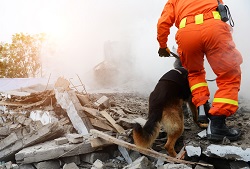Teaching Europe to bounce back from disaster
Europeans are no strangers to high-impact disasters. Ranging from natural events such as earthquakes and floods, to man-made crises in the form of cyberattacks and terrorist incidents, such disasters are becoming increasingly frequent and more severe. This jeopardises critical infrastructures (CIs) like power grids, transport networks and telecommunications systems – that are essential for a society and economy to function. We need to ensure that our modern societies are better equipped to withstand and bounce back from both expected and unexpected crises. In response to this need, five EU-funded projects, DARWIN, IMPROVER, RESILENS, RESOLUTE and SMR, have developed guidelines for improving European cities’ resilience to natural and man-made disasters. Their efforts have culminated in a ‘White Paper on Resilience Management Guidelines for Critical Infrastructures’. The report provides key recommendations for policymakers to improve policy and implementation strategies throughout the EU. The White Paper presenting the new guidelines was launched at the Critical Infrastructure Resilience 2018 Conference held in Brussels on 10 April. Resilience experts and end users across the five projects spoke on topics such as resilience intervention tools and benefits, resilience policy, standardisation and current needs, further needs and a roadmap to integration. Techniques and tools for resilience To support uptake of the resilience management guidelines, the projects developed a series of techniques and tools. These include conferences and industry presentations, webinars, workshops, and experiments providing hands-on experiences to engage end users. To teach players about resilience concepts, DARWIN developed a serious game based on virtual reality. RESILENS activities included the creation of an e-learning hub and a resilience management matrix and audit toolkit. SMR developed a Resilience Maturity Model, a strategic tool that provides an ideal roadmap for how the resilience building process should be. Its Resilience Information and Communication Portal, another of its project outputs, serves as a toolbox that can complement and enhance the platforms and software that cities already have in place. IMPROVER’s cooperation with the European Reference Network for CI Protection has yielded a series of CI operator workshops on CI resilience to ensure that practitioners both inform and benefit from the project’s work. RESOLUTE’s focus on urban transport resilience has resulted in a game-based training app aimed at improving citizen preparation. Another project outcome is an emergency mobile app to keep citizens updated and advise them on what action to take to stay safe in an emergency. DARWIN (Expecting the unexpected and know how to respond), IMPROVER (Improved risk evaluation and implementation of resilience concepts to critical infrastructure), RESILENS (RESILENS: Realising European ReSiliencE for CritIcaL INfraStructure), RESOLUTE (RESilience management guidelines and Operationalization appLied to Urban Transport Environment), and SMR (Smart Mature Resilience) are now drawing to a close. The European resilience management guidelines resulting from their efforts will guide stakeholders towards helping Europe’s cities to respond to crises more quickly and effectively. For more information, please see: DARWIN project website IMPROVER project website RESILENS project website RESOLUTE project website SMR project website
Countries
Spain, Ireland, Italy, Norway, Sweden



